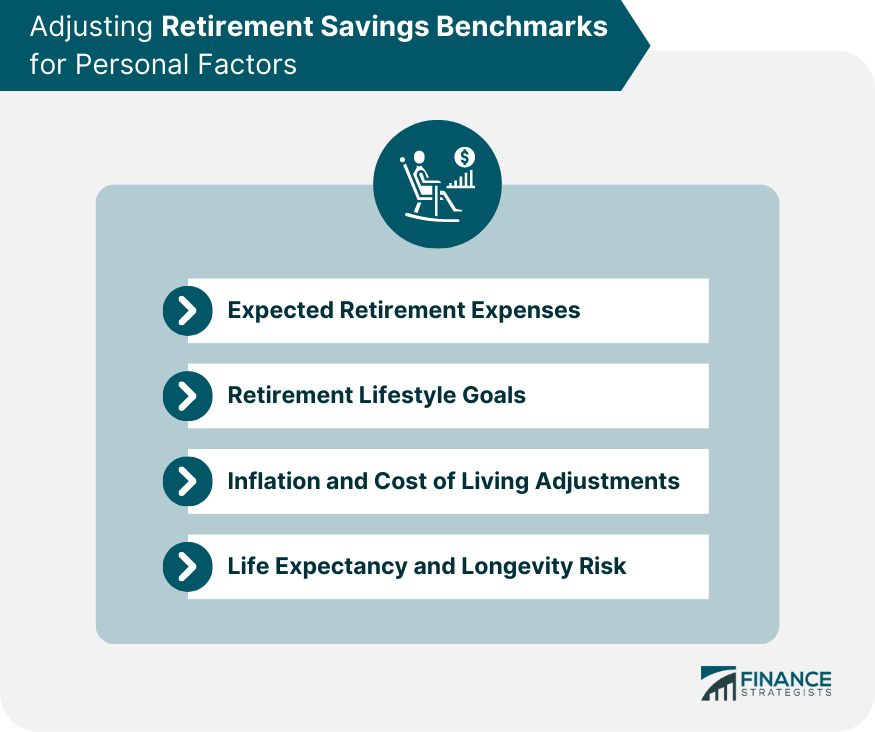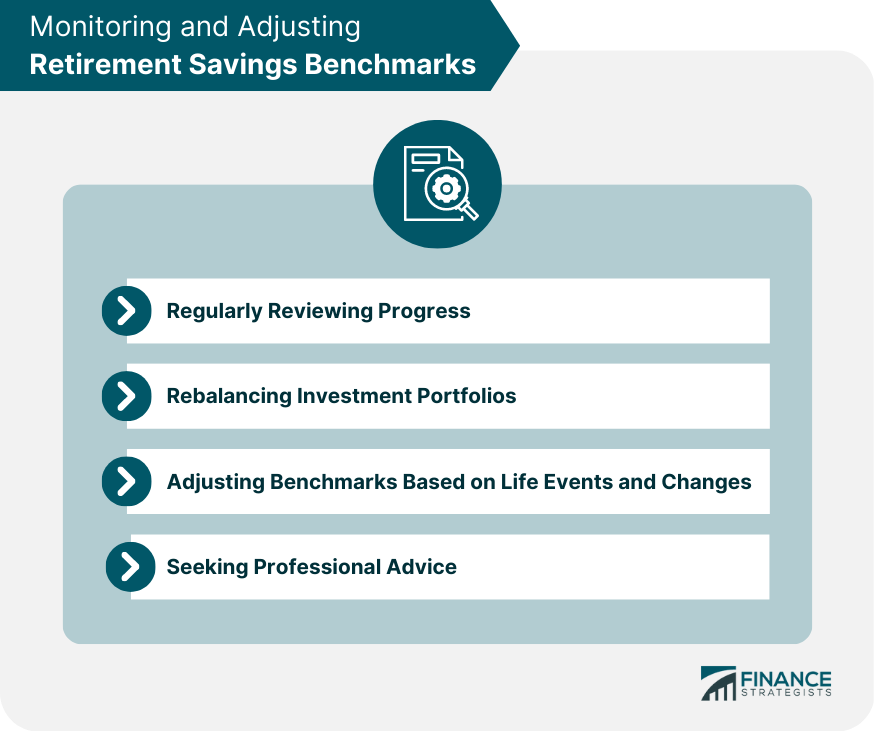Retirement savings benchmarks refer to the standards or goals individuals should aim to achieve by a certain age or point in their lives in terms of the amount of money they have saved for retirement. These benchmarks vary based on factors such as age, income level, retirement goals, and lifestyle expectations. Retirement savings benchmarks are important because they provide a tangible goal for individuals to strive towards, making it easier for them to track their progress and make informed decisions regarding their financial future. These benchmarks also serve as a reminder of the importance of saving for retirement early on, as the earlier individuals start saving, the more time their investments have to grow and compound. Meeting retirement savings benchmarks can help individuals feel more financially secure and confident about their future, knowing they have set aside enough money to support themselves during their retirement years. It's crucial to set age-specific benchmarks to assess your retirement savings progress. While these benchmarks may vary depending on personal circumstances, the following general guidelines can serve as a starting point: 1. 20s: Aim to save at least 1x your annual salary by age 30. 2. 30s: Aim to save at least 3x your annual salary by age 40. 3. 40s: Aim to save at least 6x your annual salary by age 50. 4. 50s: Aim to save at least 8x your annual salary by age 60. 5. 60s and beyond: Aim to save at least 10x your annual salary by retirement age. Keep in mind that these age-based benchmarks are not one-size-fits-all. Factors such as career trajectory, family size, and anticipated retirement expenses can impact the amount you should save. Adjust these benchmarks according to your unique circumstances. Income-based benchmarks offer another perspective for evaluating your retirement savings. It's essential to maintain a consistent savings rate, regardless of your income level. Here are some suggested savings rates by income: 1. Low-income earners: Aim to save at least 10% of your income. 2. Middle-income earners: Aim to save at least 15% of your income. 3. High-income earners: Aim to save at least 20% of your income. A consistent savings rate can significantly impact your retirement savings over time, particularly when considering the power of compound interest. Prioritize saving a set percentage of your income, even during times of financial uncertainty. As your income changes, adjust your retirement savings benchmarks to reflect your current financial situation. Increased income may allow for higher contributions, while a decrease in income may necessitate temporarily reduced contributions. 1. 401(k) plans: These tax-advantaged plans allow employees to contribute pre-tax dollars, with some employers offering matching contributions. 2. 403(b) plans: Similar to 401(k) plans, these are designed for employees of certain non-profit organizations and public-sector employers. 3. Pensions: Employer-sponsored defined benefit plans that provide a set monthly income during retirement, based on factors such as years of service and salary. 1. Traditional IRAs: These tax-deferred accounts allow for deductible contributions, with taxes paid upon withdrawal during retirement. 2. Roth IRAs: Contributions to these accounts are made with after-tax dollars, with tax-free withdrawals in retirement, subject to certain conditions. HSAs offer a tax-advantaged way to save for healthcare expenses during retirement, in conjunction with a high-deductible health plan (HDHP). Annuities provide a steady stream of income during retirement and can be purchased through insurance companies. Understanding the tax implications of various retirement savings vehicles is crucial for maximizing your savings and minimizing your tax burden. Work with a financial professional or tax advisor to create a tax-efficient strategy tailored to your specific situation. 1. Understanding benefit calculations: Social Security benefits are determined based on your highest-earning 35 years of work and the age at which you claim benefits. 2. Maximizing benefits through claiming strategies: Delaying your claim beyond your full retirement age can result in higher monthly benefits, while claiming early may reduce them. 1. Types of pension plans: Defined benefit plans provide a set monthly income, while defined contribution plans allow for individual investment choices within the plan. 2. Understanding pension calculations: Pension benefits are typically based on factors such as years of service, salary, and a specific benefit formula. 1. Living expenses: Estimate your monthly living expenses during retirement, including housing, utilities, groceries, and transportation. 2. Healthcare costs: Plan for potential healthcare expenses, including premiums, copays, and long-term care. 3. Travel and leisure activities: Budget for hobbies, travel, and other activities that you plan to pursue during retirement. Consider how your desired retirement lifestyle may impact your savings benchmarks. Luxurious travel plans, for example, may require a higher savings rate than a more modest lifestyle. Incorporate inflation and cost of living adjustments into your retirement savings benchmarks to maintain your purchasing power during retirement. Estimate your life expectancy and consider the potential risk of outliving your retirement savings. Adjust your benchmarks accordingly to mitigate this risk. Regularly assess your progress toward your retirement savings benchmarks and make adjustments as needed to stay on track. Periodically review and rebalance your investment portfolio to ensure it remains aligned with your risk tolerance, financial goals, and time horizon. Significant life events, such as marriage, divorce, or job changes, may necessitate adjustments to your retirement savings benchmarks. Consult with a financial professional to help you establish, monitor, and adjust your retirement savings benchmarks based on your unique circumstances. Establishing and working towards retirement savings benchmarks is a critical component of achieving a secure and comfortable retirement. By taking into account factors such as age, income, and personal circumstances, individuals can create a solid financial foundation for their future. Monitoring progress regularly, adjusting benchmarks as needed, and incorporating changes in life circumstances are essential for staying on track and realizing one's retirement goals. Furthermore, seeking professional advice and guidance can greatly enhance an individual's ability to navigate the complexities of retirement planning. Financial professionals can help tailor benchmarks and strategies based on unique situations, while offering valuable insights on tax-efficient strategies and investment management. With proper planning, preparation, and adaptability, individuals can look forward to a fulfilling and financially secure retirement.What Are Retirement Savings Benchmarks?
Age-Based Retirement Savings Benchmarks
Savings Benchmarks by Age Brackets
Adjusting Benchmarks for Individual Circumstances
Income-Based Retirement Savings Benchmarks
Savings Benchmarks by Income Brackets
Importance of Maintaining a Consistent Savings Rate
Adjusting Savings Benchmarks for Changes in Income
Retirement Savings Vehicles
Employer-Sponsored Retirement Plans
Individual Retirement Accounts (IRAs)
Health Savings Accounts (HSAs)
Annuities and Other Insurance Products
Tax Implications and Strategies
The Role of Social Security and Pensions
Social Security Benefits
Pension Benefits
Adjusting Retirement Savings Benchmarks for Personal Factors
Expected Retirement Expenses
Retirement Lifestyle Goals
Inflation and Cost of Living Adjustments
Life Expectancy and Longevity Risk

Monitoring and Adjusting Retirement Savings Benchmarks
Regularly Reviewing Progress
Rebalancing Investment Portfolios
Adjusting Benchmarks Based on Life Events and Changes
Seeking Professional Advice

Conclusion
Retirement Savings Benchmarks FAQs
A retirement savings benchmark is a standard or goal that individuals can use to measure their retirement savings progress against other people of similar age, income, and other demographic factors.
Some common retirement savings benchmarks include having 1x or 2x your annual income saved by age 35, having 3x your annual income saved by age 45, and having 10x your annual income saved by age 67.
The retirement savings benchmark that you should aim for depends on your age, income, lifestyle, and other factors. You can use online retirement calculators, consult with a financial advisor, or compare your savings to benchmarks for people with similar demographic profiles.
If you haven't met your retirement savings benchmark, it's never too late to start saving. You can increase your savings rate, cut expenses, or work longer to make up for lost time.
It's possible to retire comfortably without meeting your retirement savings benchmark, but it depends on your lifestyle, expenses, and other factors. You may need to make adjustments to your retirement plan, such as downsizing your home or working part-time during retirement.
True Tamplin is a published author, public speaker, CEO of UpDigital, and founder of Finance Strategists.
True is a Certified Educator in Personal Finance (CEPF®), author of The Handy Financial Ratios Guide, a member of the Society for Advancing Business Editing and Writing, contributes to his financial education site, Finance Strategists, and has spoken to various financial communities such as the CFA Institute, as well as university students like his Alma mater, Biola University, where he received a bachelor of science in business and data analytics.
To learn more about True, visit his personal website or view his author profiles on Amazon, Nasdaq and Forbes.















